On the NuDesign Sensibility
Dear Reader,
Welcome to my psyche. Behold the values that drive my work and give me enormous passion in life. Please embrace the important worldly issues that cross my mind daily, the people working to solve these problems, and the forecasting of what maybe we should not be more mindful of how we treat our one Earth.
A.S.
(N⦁1)
On technology influence
& new #social behaviours
Doomed vs. blessed by innovation
We live in weird times. The internet’s promise of making human contact easier became a nightmare and led us to anti-social behaviours. We have become immaterial beings with a constant feeling of hyperconnection.
The age of consumer euphoria is over. The sharing economy and lack of ownership are starting to bloom, from brands like Airbnb to clothing rental services. Fluidity is the new norm: from our career path to our gender, self-definitions have become passé. Data economics, harvests, and colonisations are all the rage. Pantone has chosen “Living Coral” as the colour of the year 2019 to raise awareness of coral reef bleaching and climate change. Private companies want to colonise the cosmos and create our new home on Mars without proper scientific research.
Are we doomed or blessed to live in a world where human decisions are replaced by dictations of algorithms? And how can we avoid being predictable to the algorithms and stay as a modern rebel? Even if we might be living in information democracy and can “google” absolutely everything in our times, would we be discussing blockchain news with a grocery seller?
Brain (T)Error
We are victims of our tools
While technological development has provided the utmost value in our daily lives, it has also brought many new problems. New physical and mental health problems have been introduced by new-age technology. Some examples are:
Digiphrenia
Mental disorder caused by the constant bombardment of digital input. People suffering from digiphrenia have dual personalities – the real self and the virtual one existing in a single moment. This insane mental split creates a lack of control over life, integrity, and objectivity. Frankly speaking, however, who really hasn’t felt the influence of hyper connection?

Image by Daniel Parker
Dark Euphoria
“is what the twenty-teens feels like. Things are just falling apart; you can’t believe the possibilities, it’s like anything is possible, but you never realized you’re going to have to dread it so much. It’s like a leap into the unknown. You’re falling toward Earth at nine hundred kilometers an hour, and then you realize there’s no earth there.
“That’s a dark euphoria feeling. It’s the cultural temperament of the coming decade.” – Bruce Sterling, 2009
BlackBerry orphans
Children who are often ignored by parents who tend to be exhibiting more anti-social behaviour than their own teenage children.
Memethink
“cultural dynamic happening(…), where people pick up on ideas and repeat them in both image and text-based forms. Of course, social media enables this.”
Generally speaking, it’s when your mind thinks all the time about how to convert your daily situations into memes. Because why not spend major of your life seeking attention and creating images that might make other people on the internet laugh?

Phobia of a technological singularity
The fear of a hypothetical circumstance in which AI machines, and technology in general, would beat the intelligence of humans and become uncontrollable.
Be careful… robots are coming, and they know no mercy, emotions, and peace.
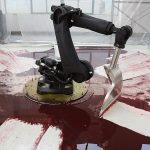
Work & image courtesy Sun Yuan & Peng Yu
Sex-robots and VR sex
While these were invented to prevent loneliness and anxiety, they are making those issues worse by making people anti-social.
Sex-robot brothels exist! Barcelona and Turin are known to have these establishments, and it is only becoming more mainstream. Even more problematic are child-size sex-humanoids and the ethics of their usage.

Image by Chanel 4
Deaths and serious injuries related to selfies
(no, it’s not a joke)
It sounds frivolous, but it’s happened many a time. Accidents have occurred during or after taking a selfie.
Some accidents are connected to falling from buildings or cliffs, a few linked to electric shocks, and even more intensely, some happen with firearms in the periphery! In 2015, a 19-year-old from Houston died after trying to take an Instagram selfie while holding a loaded gun to his head. He accidentally fired the gun and shot himself in the throat. Rest in peace, dear Instagrammer!

Image by George Kourounis
Techetox
Conscious detox for a mind reset without prescription.
Everybody’s heard of the term “digital detox”. It became a scoop in 2016, but how many of us can really take a digital break for longer than one week? And who really can afford such a luxury of total internet disconnection in the modern world? While JOMO (“joy of missing out”) is starting to be more popular than FOMO (“fear of missing out”)–which is quite a positive change–who hasn’t ever been periodically tempted by the “connectivity creep” and then gone on to check their most recent notifications?
We have developed many mechanisms for connection and exchange in our history, from books and the radio to money and social media. The problem? The media and technologies we are creating to connect with each other are not especially humanly social and have, ironically, enabled alienation. Social media also feels like a second, if not first, job. As a society, we invest so much of our emotions into it, which is highly addictive.
If we become too heavily reliant on technology (computers, software, the internet, and social media – the wide gamut), we no longer become our own independent masters, and our tools will shape our aims. If technology gains too much power over us, we might become controlled hostages without the freedom to choose what we want to archive.

Frame from the video by EverythingApplePro
(N⦁2)
Anthropo(centric)… Everything
In the epoch of human predominance
After 12,000 years of a relatively stable and calm epoch, we entered the epoch of Anthropocene. The term Anthropocene, from the Ancient Greek word “Anthropos”, which means “human.” Central to the understanding of this new epoch is that humans have become the predominant force of change on Earth and that nature is modified to such an extent that it no longer exists in any kind of “natural” state. It has consequences for the future, existence, and evolution of humankind, fauna, and flora.

Film frame from „ANTHROPOCENE: THE HUMAN EPOCH – THE DOCUMENTARY”
We not only modified the Earth’s surface by building towns, cities, and roads, but we developed more and more sophisticated materials, devices and tools, that are not fully recyclable. The estimated full weight of everything we have ever built and manufactured is around 30 trillion tonnes. All of this will survive in rocks for millions of years as “technofossils.”

Image by Christopher Locke
Imagine geologists in the future examining the layers of technofossils. They will see evidence of our sudden impact on the planet, including fossilised non-melting plastics and layers of carbons, burning fuels, and radioactive particles from nuclear tests and explosions. We can already observe these layers of rocks forming nowadays.

Image by Edward Burtynsky
A mixture of beach sediments, lava dust, and molten plastic create entirely new types of stones called “plastiglomerates”, first noticed in 2006 on a Hawaiian beach.

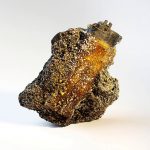
Images by Kelly Jazvac & Kelly Wood

Image by Eat Pomegranate Photography
The Anthropocene is not only a time of manmade disruption. It is also a moment of painful self-awareness, in which we are becoming conscious of ourselves as a planetary force. We are not only driving global warming and ecological destruction; we are aware that we are. Now, doing anything is an environmental question or issue. That is why coral bleaching is not just occurring on the reefs; it is happening wherever you switch on the air conditioning. Long story short, “everything is interconnected.”
Another important topic in the “Anthropocene” is space colonisation. Stephen Hawking, a famous astrophysicist, predicted that we could face extinction if humanity fails to colonize space within 100 years. As the Galaxy becomes more commercial and exploration more accessible, the power shifts to private companies like SpaceX, Blue Origin, or Rocket Lab, who lead the research of settling on Mars or deploying terraforming pods on planets across the Galaxy. Scientists hope that by 2027 we will be able to make it happen. As of 2019, the Martian surface hosts six robotic rovers, constantly collecting data and images….but, funnily enough, no human has stepped on this planet yet, so the formation of a Martian Colony Revolution in a few years still seems like a hardcore fantasy.

Image by NASA
To live on The Red Planet, terraforming must take place. Terraforming is the hypothetical process of changing a planet’s conditions to make it habitable for Earth’s plants, animals, and humans. Some have speculated that we humans will heat up Mars, resulting in ice melting and releasing carbon dioxide, ultimately creating a thicker atmosphere that is breathable for us. Basically, we need to do what we do best – another global warming, and voila! It might only take, plus or minus, 10,000 years, so… sorry nerdy dreamers, it likely won’t happen in our lifetime…
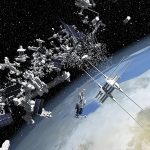
Image by Volker Möhrke/Corbis/Getty Images
Ironically enough, before even functioning in space, we’ve damaged it. Space junk has been accumulating since the first human-made satellite, Sputnik 1. This junk, known as “space debris,” includes pieces of rockets, unused satellites and bolts, garbage bags, a screwdriver, and even a spatula. More than 523,000 known manmade fragments spin around our planet. This junk is currently floating faster than a speeding bullet, damaging satellites, space stations, and telescopes.

Image by NASA
Joi Ito, director of MIT Media Lab, came up with the term “Anthropocosmos” based on the Anthropocene definition. As we are painfully aware of the human influence on the Earth, we are also accelerating into the epoch of space exploration on a mass scale. Anthropocosmos is a term that captures the idea of how we must responsibly consider our role in the Universe. Some scientists have suggested recently that we need a new generation of “space planners,” “space architects,” and in general “space ethics” to protect the Galaxy from humanity’s dark side.


Images by Clouds AO, SEArch, and NASA
The manifold of those changes feels gloomy, does it not? Taking responsibility for other generations might feel harsh. The pressure is real, but if we had the power to change the Universe that has existed for a billion years, maybe with a little bit of effort and luck, we still could reverse the trajectory of destruction? We are still the same species, just with better knowledge and technology. So why not make a positive impact with our powers? And just then, maybe some of us might not want to escape to Mars…
(N⦁3)
On NuDesign Sensibility
Responsible Attitude
In recent years, the design has become more expressive, political, and polemical, and willing to reflect social and ecological changes. Before, art only had the privilege to raise those subjects, but nowadays, designers in every field can define their own views and have more control over their work. The design used to be thought of as a styling device connected to commercialism, despite the environmental or ethical conditions. In the 21st century, designers are no longer so easily ignored. We have a huge potential to make a contribution to society by communicating important issues to a larger audience.
We need designers to show us how to use technology in a positive and constructive way. From AI to cryptocurrencies, what we had only seen in sci-fi movies from our childhood has now become part of our daily lives. We artists can be a more meaningful catalyst for change, and we can become the architects of the future.

Image by Cooper Hewitt
Corporate activism & big initiatives
The catalyst for a large change
Nike, the world’s second-largest apparel company, is not a newbie to sustainability, from supply chain to production. The Swoosh recycled 6.4 billion plastic bottles since 2010, is using 75% of renewable energy across all of its owned facilities, is sourcing environmentally-friendly cotton, and is pushing materials production to the level of Flyknit, which is made out of recycled polyester. Brand’s approach is “there is no innovation without sustainability.”


Images by NIKE
Nike made a manifesto this year that includes an aim for the future – zero footwear manufacturing waste, 100% sustainable contract factories, 100% renewable energy by 2025, and carbon neutrality by 2050. This scenario sounds utopian; however, maybe it is possible?
Designers employed by Nike also have free access to Blue Ribbon Studio – an experimental studio in headquarters where they can try ikebana classes, 3D printers, metalwork tools, and a few thousand books on art, design, and architecture. That might be an excellent example of a huge corporation that has the attitudinal spirit to encourage unexpected ideas for commercial projects.
Nonetheless, it’s important to note that any angel brand does not exist without its sins. Every giga-brand trying to be more thoughtful about the environment has its downs, making some mistakes in the past… And fashion is still the second biggest sector of production that is harmful to the environment.
In addition to the massive brands trying to make an effort, young people too have produced huge initiatives. Boyan Slat, a Dutch teenager, founded The Ocean Cleanup – a non-profit organization trying to fight the biggest pollution problem by clearing the mass of plastic trash. The Ocean Cleanup designed a system with a 600-meter-long and 3-meter-deep floater with a skirt attached below that moves through the ocean’s waters, collecting plastic from the water recycled into lasting products. It is also extremely safe for marine life. The Ocean Cleanup has already removed 50% of the Great Pacific Garbage Patch in just five years. This organization is raising funds by crowdfunding to expand its practice to all the world’s oceans.

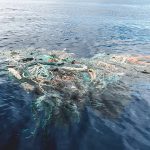
Images by The Ocean Cleanup
Some artists and corporations are collaborating to serve ecology on a large scale too! One of the most notable artists of our times, Olafur Eliasson, is not a freshman in the fight for better environmental care. The Icelandic-Danish artist has created a huge number of artworks and installations that invite the public to reflect on humanity’s effect on the Earth. In 2012, he founded Little Sun – the socially conscious business selling little solar lamps in the shape of sunflowers to deliver affordable clean energy solutions where electricity is not accessible. So far, he has sold more than 838,000 solar lamps. This year, Olafur Eliasson announced his international partnership with the furniture giant IKEA.


Images by IKEA
IKEA and Little Sun want to democratize solar-powered energy — bringing a small device into every home that allows those with or without traditional power resources to live more sustainably. The collection intends to create a solar panel that can be hung in the window during the daytime. It will store energy that can be used in the evening as a light source or charging the battery for small devices. Alongside the solar panel, Eliasson collaborated with IKEA on a series of subtle metal structures to contain the batteries and allow them to be used as laps in the home. Design features a lot of interlocking metal rings that are forming orbits around the battery and with the light source glowing from the inside of a construction. They are intended for indoor and outdoor use.
Bit by Bit
Independent & valuable creations
The aforementioned practices are bold and can feel overwhelming, especially when an individual wants to create something personal and independent that is valuable to sustainability. But it’s all about the ripple effect – change can also happen bit by bit.
Italian duo, Studio Formafantasma, created a stunning project called “Ore Streams,” focused on the relationship between design and digital waste, called e-waste. The project was developed over two years of research and comprised of different media, including physical objects, video documentary, and animations. They interviewed recyclers, activists, scientists, policymakers, and other experts. Based on collected information, they created a series of objects: a table, desk, chair, bin, cabinet, and screens, each made from salvaged materials and components constructed from recycled digital junk. All of the pieces were designed for use in an imaginary office. This decision was not random: the office environment explained the designers “is where modern design principles are most visible.”
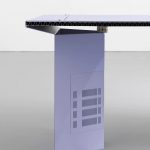

Images & works by Studio Formafantasma
The only ⅓ of digital trash is officially collected nowadays. “Ore” is the term describing rock from which any valuable metal can be derived. According to Studio Formafantasma, by 2080, the largest metal reserves will no longer be below ground. They’ll be above it in our smartphones, devices, and other forms of wealth. Instead of sourcing metals from the Earth, it will be “remined” from the millions of tons of e-waste that the world produces, which the studio named “above-ground mining.” The project contains special recommendations– for policymakers and companies but also designers and engineers, who are “ignorant of the complications they’re creating for the recycling process” with their creations. This Italian duo clearly believes that designers have the power to make products that last longer and are much easier to recycle. Studio Formafantasma is encouraging all people connected to the process of technological production to prioritise recyclability in their work by taking actions such as improving labelling parts, avoiding the use of glue to fix different materials together, ensuring that batteries and other harmful components are easy to access and remove, and many, many more.

Image by Studio Formafantasma
“Ore Streams” is an important body of work starting a wider conversation with the creative world about the ethics of designing non-recyclable products and about e-waste. With this multidisciplinary series, Studio Formafantasma addresses a complex issue, suggesting that design can become a positive force for global change.


Images by Sepro Urban Metal Systems & Studio Formafantasma
Another example of independent initiative can be Jessica Gregory’s practice. She is a designer with interest in bio-technologies and organic aesthetics. Her work focuses on creating objects and materials for human and environmental well-being. She thinks that by using bio-based alternatives to harmful materials such as plastic, we can enter the era of growing what we consume and create greater synergy between us and our environment.



Images by Haeckels
Her project, “BIHOME,” is a series of systems to create objects in the process of growing them on your own at home. Materials are made from household wastes and are divided into two types: bacterial cellulose and mycelium. The bacterial cellulose is a leather-like material growing out of sugars from food waste as nutrition for bacteria. The mycelium is the fast-growing root system of mushrooms that creates plastic-like material. For its production, food waste can be used, for example, coffee grounds, to create desired shapes. She recently collaborated with Heackels to develop a series of sustainable packaging designs for their natural skincare products.
Ada(mant) practices
The synergy of Nature & Machine
As for me, the natural and mechanical realms are both valuable to me. Fauna and flora are the best visual stimulus, and computers allow us to play with their features in a distinctive way. I constantly need to be around both but cannot have far more of one over the other.


Visuals by Ada Sokol for KENZO, NIKE & personal project
In that sense, I conceptually love narratives connected to both nature and new technologies. That is my way to find a balance between the natural and mechanical realm, even if it sounds cliche.
Sometimes commercialism understands freedom without limits. Together with Gentle Monster, we created a project about escaping the constraints of universal branding rules. Advertorial, in which you can destroy the product, is a rare gem. The sunglasses in this project are melting like liquefied plastic pulp. The dissonance between imagination and typical commerce is blurring.

Visuals by Ada Sokol for KENZO, NIKE & personal project
You might recall the space colonisation that I touched upon earlier on… This is another example of the project created with Gentle Monster, Selfridges, and Dover Street Market New York. It is also quite abstract and shows that commercialism can be more art-focused.
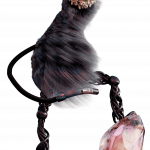
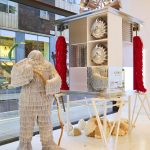
Visuals by Ada Sokol for Gentle Monster, Dover Street Market NY & Selfridges
One of my projects can be an example of the possible co-existence of design, commercialism, and activism. For Rimowa, critically endangered amphibians have been brought to the forefront in one animation. Axolotls are almost extinct species in their natural habitat (trivia: they are more common as pets in Asia) but are still not widely known worldwide. More people might become curious about axolotls by using them as a principal character in an advertorial for a highly-known brand.

Visuals by Ada Sokol for Rimowa
Nowadays, there is a huge demand for sustainability not only in the fields of production but also in visual communication. 3D fills the gap between product production and image-making in an era when way too much waste is created. What if we can visualise completely new products or objects and sell them to customers before it was even manufactured? When brands are launching new products, it is easier and safer to use 3D. What is more, some designs would not be possible in reality, but with 3D technology, they can be shown in a photorealistic way.



Sketch by Etienne Garachon, images by Ada Sokol & Etienne Garachon
With Etienne Garachon, we created two fictional jewelry brands: “Shimo” & “AMA.” Together we brought to life pieces that never existed in reality and showed them to the world as advertorial. We developed absolutely every detail from start to finish – from the story behind the brand, its name and logo, the emotions each piece of jewelry should evoke, and the ultimate jewelry designs that would physically represent the brand’s narrative and values. In this way, we disrupted both the manufacturing and visual communication processes.



Images by Ada Sokol & Etienne Garachon
Attitude: Sense(ability)
Positive chain reaction
It’s a stunning chain reaction – sensibility helps imagination, imagination helps creativity, and creativity helps progress. Sensibility separates us from machines and other animals, both individually and collectively. Sensibility will benefit us as we look towards the future. Sensibility will help us create a more responsible, sustainably designed world.
Is it possible that our new attitude would be “stay sensitive”?

